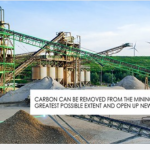Miners to focus on carbon reduction, community support and health & safety – GIBB

Alan Wingrove – GIBB Mining General Manager.
Despite the challenges brought about by the Covid-19 pandemic, the issues of reducing greenhouse-gas emissions, improving health and safety and creating value for surrounding communities require urgent and ongoing attention, says multi-disciplinary engineering consultancy GIBB mining division MD Alan Wingrove.
He points out that although Covid-19 pandemic protocols have been “exceptionally well managed” by the South African mining industry, other pressing challenges are demanding renewed attention.
These include reducing carbon footprints, enhancing health and safety measures and creating sustainable communities beyond the life of the mine.
In terms of carbon emissions, miners globally are being challenged by the pursuit of net-zero emissions by 2050, in alignment with the 2015 Paris Agreement.
As such, Wingrove says strategies to address carbon reduction must include the streamlining of operational efficiencies, the use of renewable energy and the electrification of equipment.
“There has already been a significant commitment made by the mining sector to progressively move away from diesel to battery-powered vehicles or vehicles using hydrogen fuel cells.
“[As an example], Anglo American is testing a haul-truck using a hydrogen fuel cell and battery combination with the intention of expanding it to all operations.”
Further, with the Department of Mineral Resources and Energy’s stated commitment to permit mines to generate some of their own energy, most of the large mining houses are pursuing alternative energy sources, especially solar power, he says.
In this regard, Wingrove notes that mines have an advantage when it comes to renewable energy as they generally have the space to install solar or wind technology.
For the time being, miners’ distributed generation schemes will supplement the electricity supply from Eskom, thereby reducing the burden on the main grid.
The licensing of such processes, including the wheeling of power across the Eskom grid, needs to be clearly documented and supported by the National Energy Regulator of South Africa, he says.
Wingrove adds that incorporating renewable energy sources into the power mix has become more viable as demand for these technologies has intensified and made it a more affordable option.
COMMUNITY UPLIFTMENT
Creating “real value” for local communities is a key consideration for the mining industry, he says, adding that local communities are key stakeholders in mining projects and securing their buy-in or a social licence to operate requires a multi-faceted approach.
“Not only do mining houses need to provide job opportunities and transfer skills to people in local communities, they need to have strategies in place that facilitate sustainability beyond the life-of-mine.”
Wingrove says that, in many instances, they also need to explore the creation of enabling infrastructure, such as roads, hospitals and schools, as well as health services and information and communications technology networks, besides others.
Importantly, he says mining houses need to ensure local communities are engaged with from the outset of new mine developments and/or expansion opportunities and need to be equipped with the skills and means to sustain themselves beyond the life of the mine.
“This requires a deep understanding of the issues they deal with on a daily basis and determining what their expectations are beyond the life-of-mine, rather than the mine deciding what it believes is best for the community.”
Health and safety is a key focus area for mining houses with the emphasis on finding ways to improve the effectiveness of their safety management plans.
In this regard, the use of integrated digital platforms for the management of mining operations is critical for driving improved efficiencies and ensuring effective decision-making, based on equipping management teams with real-time information at their fingertips, says Wingrove.
“There is an important safety improvement spin-off in that there are a reduced number of ‘crisis management’ events, which typically result in increased safety risk [owing] to poor or misinformed decisions being taken.”
In this regard, digital platforms provide the ability to harness information from many areas of influence, equipping the management team to more fully assess and appraise “what-if” scenarios leading to quick and better-informed decisions, he says.
Wingrove says the effective use of digital platforms can help mines avoid relatively low-risk situations from escalating as a result of poor decision-making.
“When mine management is placed in a position to make good decisions, and do it quickly, they can improve the safety performance of their operations significantly,” he concludes.
Miners to focus on carbon reduction, community support and health & safety – GIBB (miningweekly.com)




